Climate change, an existential menace, has precipitated profound transformations across our planet’s archetype. It invokes a sense of urgency that cannot be overstated, as the ramifications of its progression become increasingly dire. The concept of “irreversibility” in the context of climate change describes a critical juncture—an ominous threshold beyond which certain climatic alterations may no longer be mitigated. Identifying when climate change transgresses into irreversibility is paramount to our collective survival, as it dictates the frameworks within which humanity must operate.
To comprehend this phenomenon, we must first delve into the mechanics of climate change itself. Global warming, primarily driven by anthropogenic emissions of greenhouse gases, has engendered a series of cascading effects—melting polar ice caps, rising sea levels, and shifts in weather patterns. These alterations are not merely ephemeral inconveniences; they bespeak a more ominous transformation of our environmental tapestry. Scientists argue that certain thresholds, often referred to as “tipping points,” could herald irreversible consequences for ecosystems and human society alike.
The first germane factor in this discourse pertains to the temporality of climate responses. The concept of a “carbon budget” is instrumental in elucidating this complexity. Simply put, our planet has a finite capacity to absorb carbon dioxide without incurring deleterious effects. Exceeding this budget leads to catastrophic scenarios, such as accelerated ice melt and abrupt climate transitions. The Intergovernmental Panel on Climate Change (IPCC) has posited critical carbon thresholds; crossing these limits may catalyze feedback loops that exacerbate warming beyond human control.
Moreover, one must grapple with the implications of delayed action. The inertia inherent in the climate system means that the choices made today reverberate through decades, if not centuries. For instance, the thermal lag of the oceans means that even if emissions ceased immediately, the planet would continue to warm for a prolonged period. This reality complicates our perception of time, as mitigation measures may appear futile when the consequences of inaction linger ominously on the horizon.
In addition, the interplay between natural ecosystems and human activities magnifies the potential for irreversible change. Ecosystems act as both victims and moderators of climate change. For instance, the destruction of mangroves and coral reefs, essential for carbon sequestration and coastal protection, not only exacerbates climate impacts but also diminishes nature’s capacity to sequester CO2. These intricate relationships underscore the need for holistic solutions that bridge conservation and climate action.
Foremost among the phenomena signaling an approaching crisis are the rising global temperatures themselves. The benchmark of a 1.5-degree Celsius increase above pre-industrial levels has been widely acknowledged as a critical limit. Exceeding this threshold harbors widespread risks: augmented frequency of extreme weather events, existential threats to biodiversity, and destabilized food and water supplies. It is incumbent upon us to recognize that each fraction of a degree matters in this existential calculus.
One of the more alarming markers of irreversibility emanates from melting permafrost. This phenomenon not only contributes to sea level rise but also released sequestered methane—an even more potent greenhouse gas than CO2. The feedback loop initiated by this process is one of the quintessential exhibits of how climate change can spiral out of human control. As thawing continues, vast reservoirs of carbon are released, prompting further warming in a relentless cycle.
Human societies, particularly in vulnerable regions, stand at the precipice of an irrevocable transformation. Poor communities—not only do they bear the brunt of environmental degradation—but they often lack the resources to adapt to changes that unfurl at an alarming pace. The intersection of climate injustice and societal inequities necessitates that climate adaptation strategies incorporate social justice principles to buffer against the impending crises.
Global governance mechanisms also play a pivotal role in addressing this imminent threat. International frameworks, such as the Paris Agreement, seek to unify efforts to curtail emissions on a global scale. However, the disparate commitments from various nations raise questions about collective efficacy. The willingness of powerful nations to lead by example determines if we can avert the worst of climate change’s repercussions. The collective political will to adhere to stringent emissions targets and support developing nations is crucial in the global response to climate change.
In the realm of scientific research, it is essential to bolster our understanding of the complexities involved in climate dynamics. Investment in innovative technologies that can enhance carbon capture and storage, reduce emissions, and facilitate sustainable energy production is imperative. These technological strides can serve as antecedents to a more resilient future, where humanity can coalesce with the natural world rather than exploit it.
In summation, climate change is not just an environmental issue; it is an intricate tapestry woven into the very fabric of our existence. Understanding when climate change becomes irreversible requires a multifaceted approach that intertwines scientific inquiry, public policy, ecological stewardship, and social justice. The countdown to crisis necessitates our collective vigilance, action, and accountability—only then can we hope to steer humanity towards a sustainable trajectory that honors both our planet and future generations. Time is running short; the choice rests with us.


